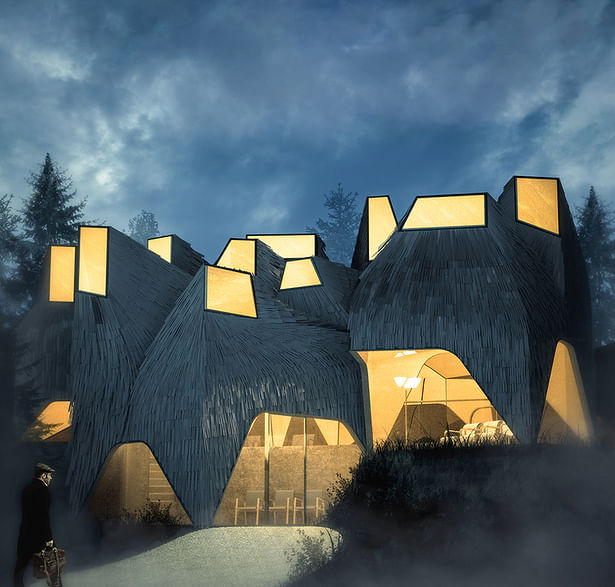

"Secret Meeting of The Silent Creatures” is an entry proposal for the International Architectural Competition for an Extension Between the Alvar Aalto Museum and the Museum of Central Finland(http://www.alvaraalto.fi/ruusupuisto/).
Concept
The new extension for the Alvar Aalto Museum and the Museum of Central Finland must pay homage to the design philosophy of the great architect yet update it with the new sensibility.
One of the distinct features in Aalto’s designs is his exquisite way of taking the natural sunlight into the interior space such as the skylights of the library in Viipuri(1935) and the roof lights of the Alvar Aalto Museum(1973). A trapezoidal “Light Tube" unit is a basic component of our proposal for the extension of the museums. Light Tube unit has a skylight window adopting Aalto’s design of the roof lights of the Alvar Aalto Museum, and it is angled at the same orientation as the roof lights of the museum are oriented.
Roof structure of our proposal is an aggregation of repetitive Light Tube units that are slightly varied in size and shape. This reminds of a differentiation and repetition technique which is apparent in many of Aalto’s designs such as Church in Vuoksenniska(1959) and Wolfsburg Cultural Center(1962).
The curvilinear floor plan allows smooth flow of people between the two museums and it echoes Aalto’s use of distinct curves in Finnish Pavilion at the World’s Fair(1939).
Our proposal for the extension achieves not only the space that enhances the continuity between the two museums but also intimacy to become a catalyst to connect the museums to the new Ruusupuisto square.
Structure and Material
Main structural component of Light Tube unit is a 9mm thick steel panel welded at an offsite factory. Interior surface is cladded in locally manufactured plywood sheets, the same material used by Aalto for many of his furnitures. Exterior is shingled with blue tinted charcoal gray colored aluminum composite panels. Its color is inspired by the color of the facade tiles of Aalto’s Seinäjoki Town Hall. Vertical lines created by the shingle will resonate with the exterior of the Aalto museum.
Construction Process
Each Light Tube unit will be fabricated at an offsite factory, taking advantage of the highly sophisticated shipbuilding technology in Finland. Size of each unit is small enough to be transported by a cargo truck and it will be assembled onsite using high tension bolts to connect the units together.
Status: Competition Entry
Location: Jyväskylä, FI
My Role: Principal